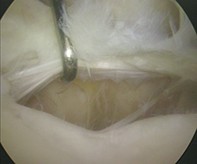First time shoulder dislocation in a young adult
Case presentation
A 20-year-old man presented to his GP two days after sustaining his first anterior shoulder dislocation in a football tackle. The dislocation had been reduced under sedation in the casualty department of the local hospital, and his arm was placed in a sling. He had not suffered a shoulder dislocation before.
On examination, the shoulder was tender and the range of motion was good but not full. The anterior apprehension sign was positive (that is, forced abduction and external rotation of the shoulder was painful). Power was normal, as was sensation in the distribution of the axillary nerve. Plain x-rays of the shoulder were normal, showing a reduced shoulder and no evidence of fracture. There was no reason to perform an ultrasound.
The patient’s sling was removed immediately and arm exercises were commenced. He was advised to see an orthopaedic surgeon as soon as possible to consider early arthroscopic intervention.

